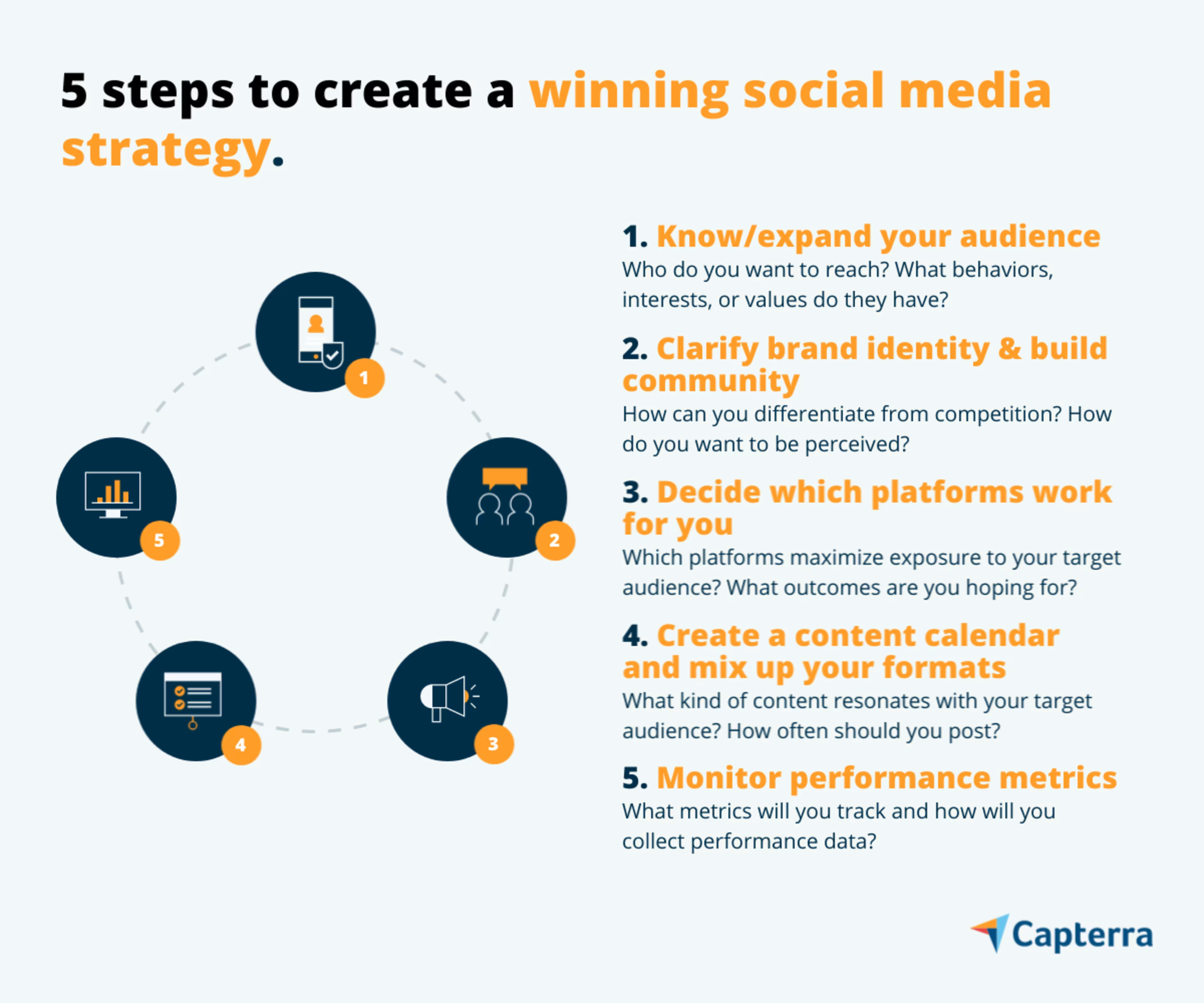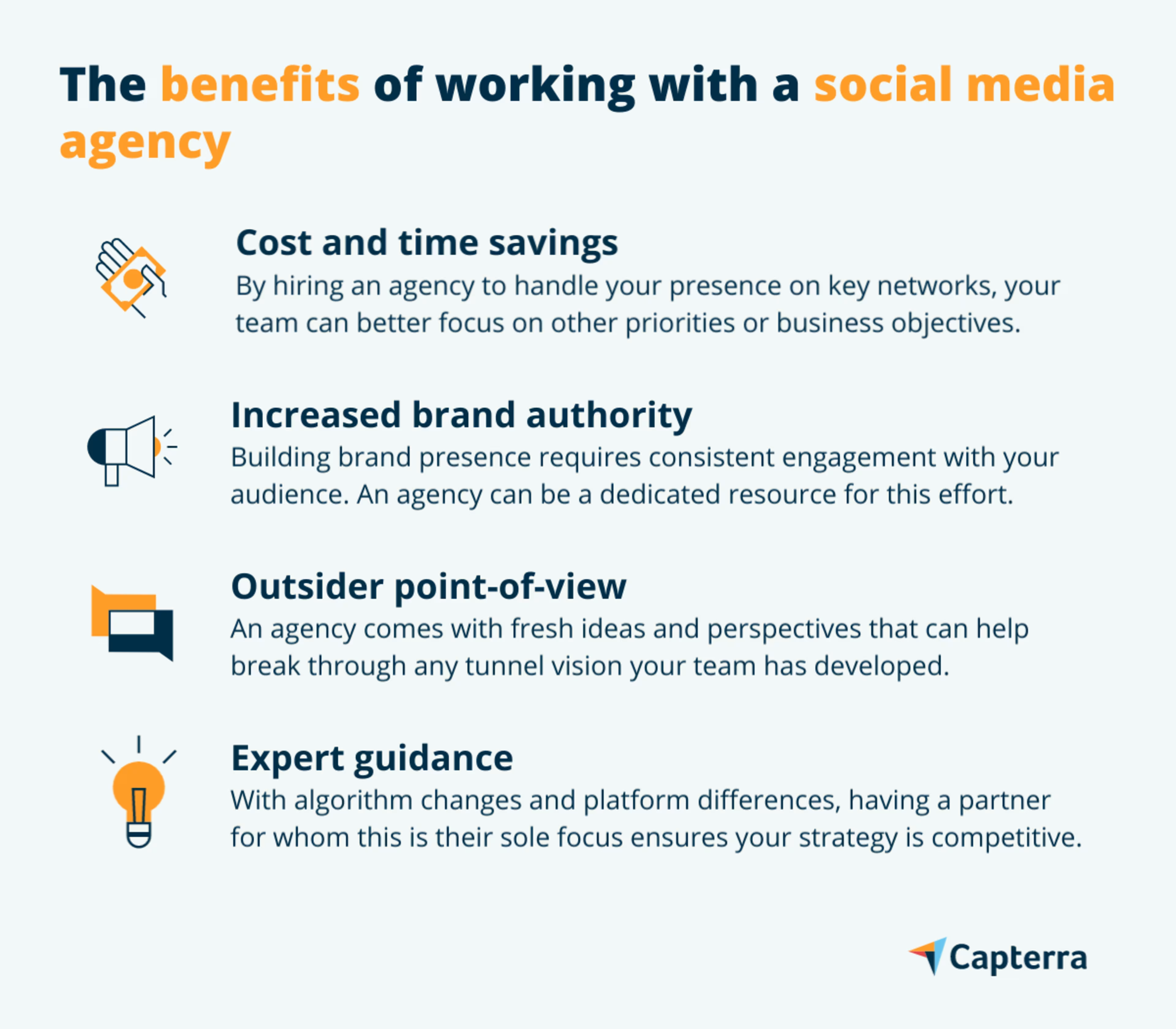This foundational guide can help anyone looking to get started on using social media to promote their business and find their target audience.
Here’s the least surprising thing you’ll read all day: Everyone is using social media.
In fact, according to Gartner’s 2021 Digital Marketing Survey, 54% of digital marketing leaders rank social media as their top channel to support digital marketing strategy—while expanding approaches to meet evolving user behaviors. In my experience working in marketing for more than 10 years, and growing my content creation business over the last four, having a social media presence that you post on occasionally and actively growing it are two very different things.
If you’re looking to better leverage your social media presence to promote your business, then keep reading.
5 steps to promote your business on social media
In just five steps, we’ll cover how to craft a social media strategy that drives attention to your products and services at scale, while also building authentic relationships along the way.

Step 1: Know and expand your audience
Social media use has ballooned to billions of users.
If you try and reach each user, though, you’re going to obviously run into all sorts of trouble. That’s why the first, most important step is understanding what your ideal follower list should look like—people outside of that definition will join your network but before you start writing one word or posting a single image, you need to understand who it is you’re talking to.
/ Questions to answer
Who do you want to reach?
What platforms are popular in your industry, and what can you learn from them?
What networks does your audience spend time on?
What age group and demographics are you targeting?
Any key behaviors, interests, and values your target audience has?
Step 2: Clarify your brand identity and build a community
Take a look at your competition and figure out ways that you can differentiate from them either from the type or medium of content that you’re posting.
At this stage, the point is not to go and copy what others are doing on social media but to realize that in order to stand out to your audience, you need to find your angle that makes you and your organization unique.
Is your organization going to be more of a comedic account that’s making your audience laugh? Or instead are you going for a more educational approach and looking to help your audience do their job better, live the life they want to lead, or otherwise fulfill the promise that your brand has.
/ Questions to answer
How do you want to be perceived by your audience?
How will your mission and vision carry through on social media?
Which visual elements represent your brand best?
What tone and voice should be used in your posts?
Step 3: Decide which platforms are right for you
Now it’s time to actually begin creating your social media strategy. It’s important to take the time and plan ahead and, most important of all, set clear goals.
Consider what you hope to achieve with your social media presence. Are you looking to generate leads, drive web traffic, or promote your latest product?
Once you have identified your objectives, you can rely on the research you did during steps one and two and start to outline which networks you’re going to be active in, how often you’re going to post, and what types of posts you’re going to create.
/ Questions to answer
What are our goals for social media? (e.g., lead generation, building relationships, improving visibility, increasing sales)?
Which platforms should be used to maximize exposure to your target audience?
Under which circumstances would it be beneficial to partner with influencers or sponsorships?
What keywords or hashtags should you use to capture the attention of potential customers?
Step 4: Establish your content calendar and mix up your formats per platform
Now that you’ve got your strategy, it’s time to start planning the tactical execution of it by building a content calendar.
A good content calendar should lay out the topics and types of posts for each platform for the entire month or year. This will provide you with a structure to follow, enabling you to stay on track and create an effective strategy that is tailored to your goals. Additionally, a content calendar helps ensure that no key dates or events are missed, ensuring that followers will always have something interesting and relevant to engage with.
/ Questions to answer
What kind of content will resonate with your target audience (e.g., behind-the-scenes photos, customer stories, educational material)?
How often should new content be posted on each platform?
Who on our team is responsible for creating and posting the content? Do we need extra help?
Step 5: Monitor performance metrics over time
Once your social media marketing engine is up and running, it’s time to get a bench mark, track results over time, and figure out where you can improve.
I’ve talked before about key social media analytics that businesses should be following. In summary, you should be tracking these six:
Reach: Total number of unique accounts that saw your post
Impressions: Number of times a post was displayed
Engagements: User interactions like reactions, shares, and comments
Direct messages: Number of people reaching out to you via personal message
Traffic and revenue should also be tracked, but it may take a bit more work to get those numbers. Add UTM tags at the end of any links that are posted on social media, and you’ll be able to track those users from social media posts to traffic on your website and, eventually, revenue.
/ Questions to answer
Do we have a way to track post performance over time?
Are we properly adding UTM tags to any links posted on social media?
Is our Google Analytics instance set up so we can follow the trajectory from social media to our website?
Advantages of hiring a social media agency
In an ideal world, your team members would have more than enough time to engage with followers and build the company’s brand through their networks. In my experience, marketing teams are often required to handle far more channels than they have the headcount to support.
Social media isn’t something that can be relegated to an afterthought. If you find that you’re viewing social media as just another item on your task list, it might be time to investigate hiring a social media agency. Doing so can free up your team’s time and comes with a host of additional benefits as well.
Cost and time efficient
Don’t let social media marketing become an afterthought or a chore. By hiring an agency to handle your presence on key networks, your team can better focus on other priority channels or business objectives, saving your team time and money in the long run.
Build authority
Building your brand’s presence on social media is never really done. It takes consistent effort and showing up and engaging with your audience day after day, week after week. By bringing in an agency to handle that, you can trust that their number one priority is to make sure each campaign or piece of content is working toward that overarching goal.
Different point of view
It can be helpful to have an outsider's point of view when developing a social media presence. Collaborating with an agency comes with fresh ideas and perspectives that can help break through the noise, especially in a crowded space.
Expert advice
Each social media network has its own quirks and preferred content types. Bringing in the right partner to provide guidance and advice on strategy, campaigns, trends, and analytics can go a long way toward ensuring that you’re building a strong social media presence. Plus, since that’s their sole focus, they can keep you in tune with the latest changes in the industry.

Need help finding the right agency? Read our Social Media Marketing Services Hiring Guide to learn what to look for in an agency and more.
Enjoy the success of your social media strategy and build your community
Social media is no longer just a place to post funny memes—though there’s still plenty of that.
The last decade or so has seen it evolve into an essential tool and channel for businesses of all sizes. Establish your brand and create a lasting presence that reaches new followers while also keeping old ones—maintaining and staying true to your strategy is a great way to keep your success going.
By following the steps above, you can be well on your way to increased visibility, building relationships, and reaching new customers.
For more Capterra resources from Nick on social media and marketing, check out the following pieces below:

